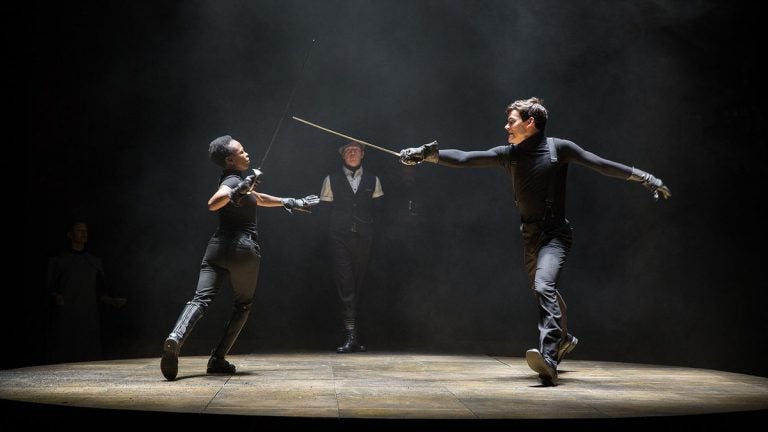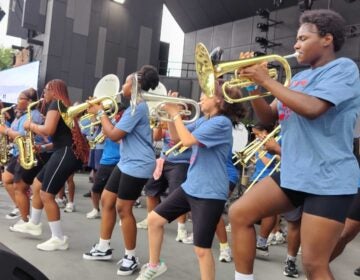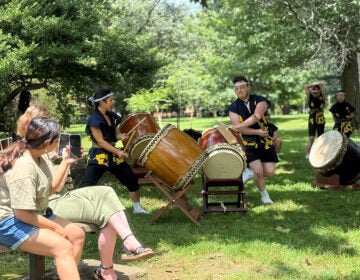Review: ‘Hamlet,’ explained and not

In Wilma Theater's production of 'Hamlet' (from left): Zainab Jah as Hamlet, Keith Conallen and Brian Ratcliffe. (Photo courtesy of Alexander Iziliaev)
To be obscure or not to be, that is the question that pervades Wilma Theater’s production of “Hamlet.” And the answer is, yes … and also no. Wilma’s artistic director, Blanka Zizka, stages the most oddly balanced “Hamlet”: For every impressive moment of clarity, it has a puzzling abstraction.
Why do the characters of the king’s court frequently take to the stage in slow motion, stopping at intervals as if some higher authority keeps pressing a pause button? They do so between the hugely swooping chords of original music by Alex Games and Emma Violet, an effect that’s at first dramatic and later, repetitive.
Why does black stone rubble spill from the stage ceiling when certain characters exit? What’s the significance of the graffiti by street artist CERA on the walls around Matt Saunders’ handsome runway set that leads to a circular playing space in old Denmark? And why does a constant stream of mist pour from the set?
Why, why, why: Why does Ophelia, played by Sarah Gliko, seem mad from her first moment on stage, when she’s clearly written as sane? (Later, when she’s supposed to be mad, not all that much seems different.) Why does her father Polonius, portrayed by Joe Guzmán, hold onto her in a pas-de-deux arm stretch as they pivot in a circle when they speak?
These conceits, or affectations, or fuzzy metaphors, are probably for added-value effect — but William Shakespeare’s text is scads more coherent than any of them. That text, in fact, is also treated with verbal affectation: Its many iconic passages are delivered with deliberate exclamation points so that we should Sit-Up!-and-Take-Notice!
But before I protest too much, methinks I should flip this theatrical coin to its other side. For all the elements I found questionable at the Wilma, the production’s stuck with me for days for its high points. It stars Zainab Jah, a Sierra Leone native and, by the end, a riveting Hamlet. The fact that Jah is a woman has spurred some excellent dramaturgy at the Wilma, where Walter Bilderback decorates the walls with information about the top 10 female Hamlets – read the posters during intermission or before the show (they’re strategically placed near the restrooms) and you’ll discover some surprises.
Zizka directs the lithe and compact Jah to flash around the stage with the freedom of a sprite – but also, to be the college student that Shakespeare intends Hamlet to be. Jah brings it off with style and a youthful purring voice. As she plans to avenge her father’s murder by her uncle, she’s not the most introspective of Hamlets, but she’s also performing in a production that fails to underscore Hamlet’s decision to feign madness to cover his plans for revenge. Among the triumphs of Jah’s interpretation is Hamlet’s accusation that his buddy Guildenstern (Jered McLenigan) is trying to play him like a flute (in this case, a recorder); so clearly did Jah make Shakespeare’s argument, gasps came from the audience the night I saw the show. Jah’s exchanges with his uncle, the king (Steven Rishard), and with Hamlet’s mother (Krista Apple-Hodge), now re-married to the king, provide outstanding moments for all three actors.
Other high points involve the supporting cast – a fine troupe featuring several of the city’s accomplished players. For this production and for the Wilma’s next – the clever follow-up choice of Tom Stoppard’s “Rosencrantz and Guildenstern Are Dead” with virtually the same cast — Zizka focused on ensemble work, and it shows. She brought in Jean-Rene Toussaint, a French theater artist whose specialty is voice work, plus another from Greece and one from Belgium; their workshop material played a role in rehearsals each day.
Clearly I have issues with the production, but not with its invigorating spirit, aided by the costumes of Vasilija Zivanic, which manage to look new-fangled and old-fashioned all at once; the crisp sound design of Zachary Beattie-Brown, and Yi Zhao’s effective and moody lighting.
I’ve saved until last one of the most striking elements of this “Hamlet” – appropriate since it comes at the play’s end: The joust between Hamlet and Laertes (Brian Ratcliffe), set up by the king. It’s the scariest and most realistic swordplay in my recent memory, choreographed by fight director Ian Rose and delivered by Jah and Ratcliffe as if it were spontaneous. They move from the stage’s central platform onto the black-pebble surface, where they stretch, fall, recover and resume their chase – jousting all the while. It’s exhilarating to watch. And completely understandable.
“Hamlet” has been extended through May 2 at Wilma Theater, on Broad Street between Locust and Spruce Streets. 215-546-7824 or www.wilmatheater.org.
WHYY is your source for fact-based, in-depth journalism and information. As a nonprofit organization, we rely on financial support from readers like you. Please give today.




